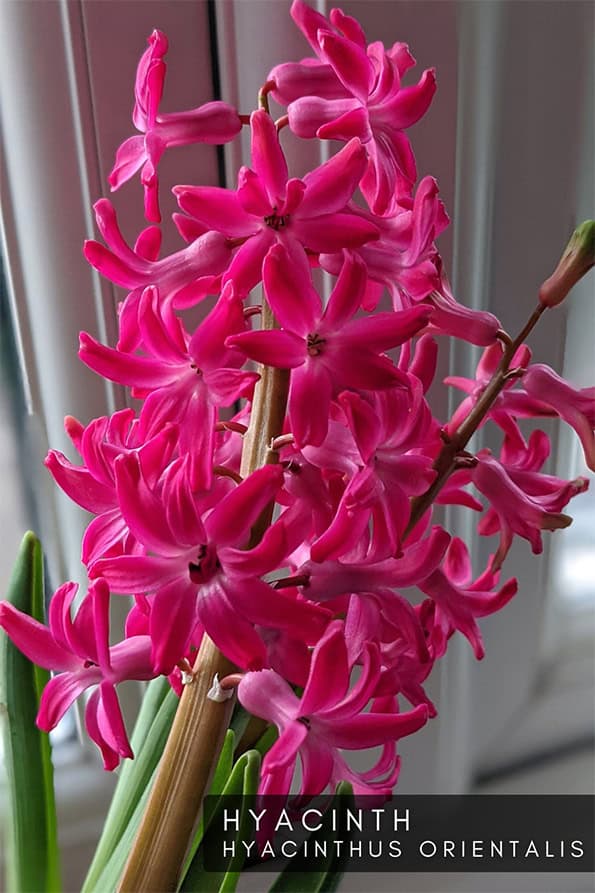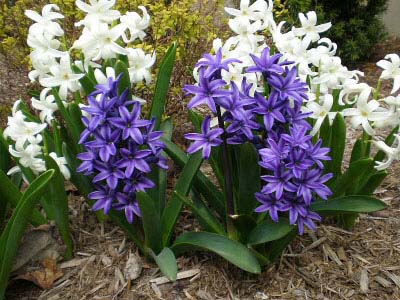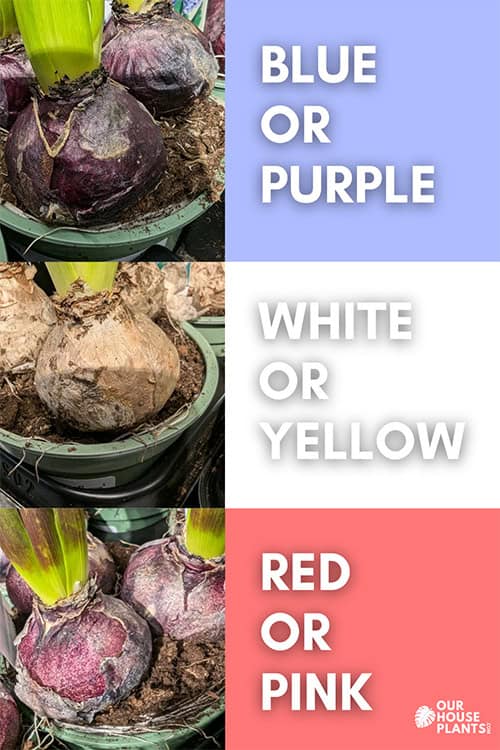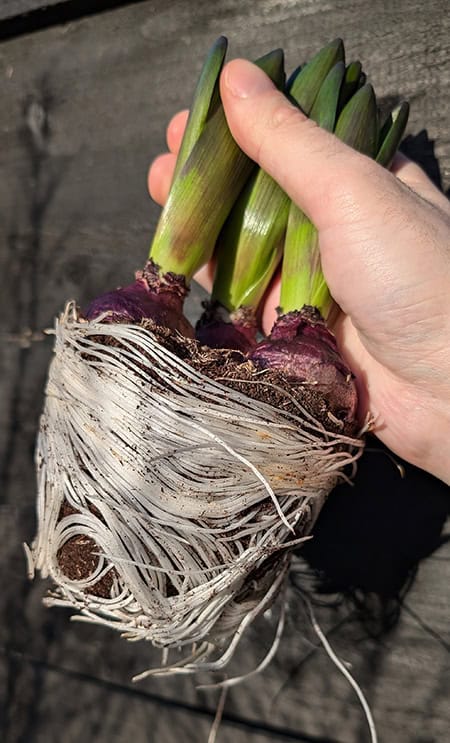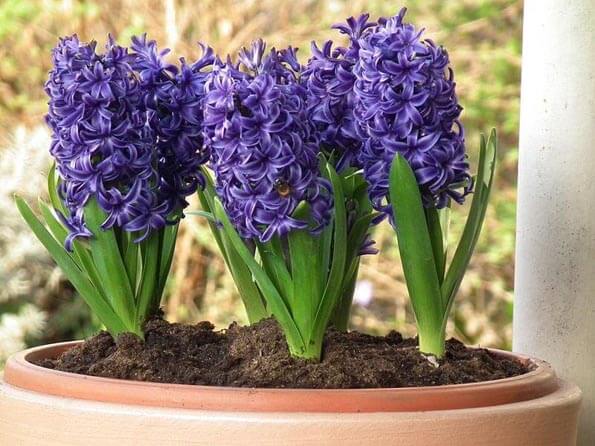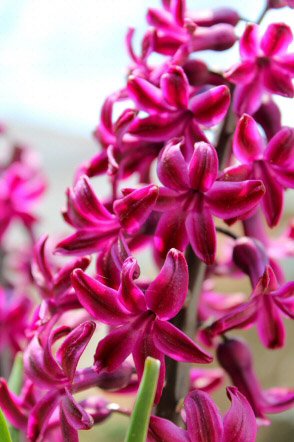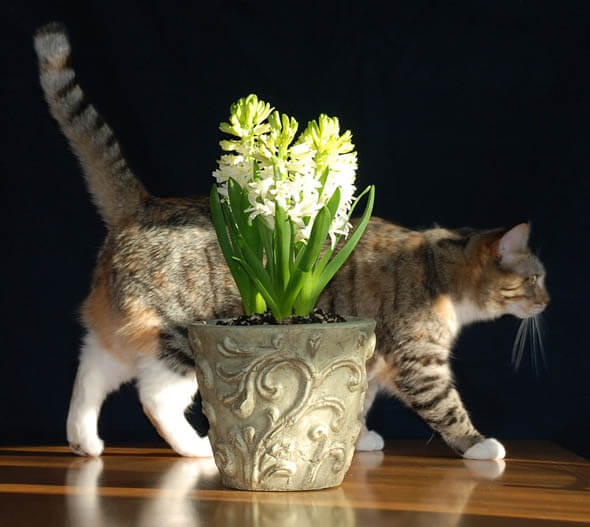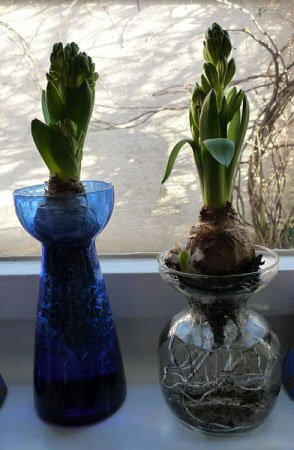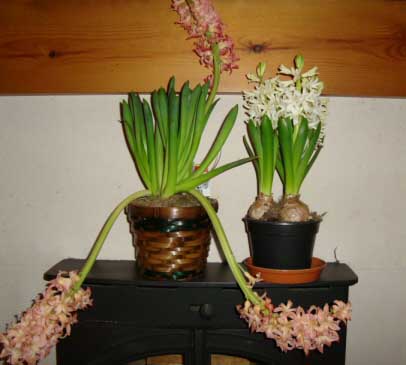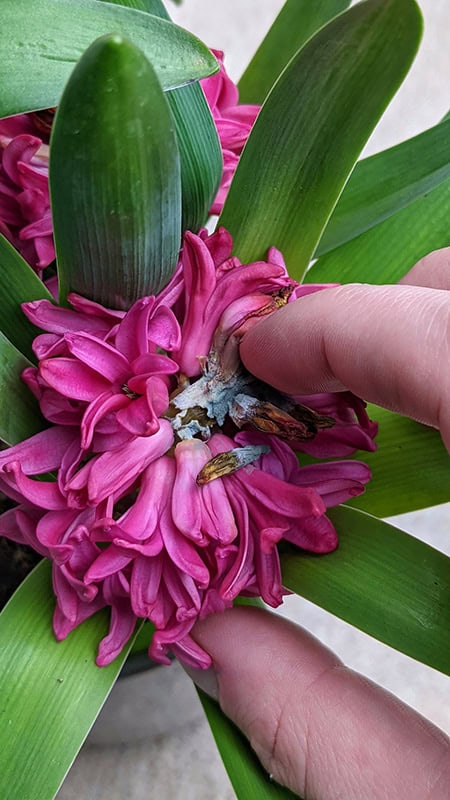Imagine filling your home with the intoxicating fragrance of spring in the middle of winter. That's the magic of indoor Hyacinths!
The Dutch Hyacinth is more well known as an outdoor garden bulb that flowers in spring and gives off a glorious floral scent. However over the last few decades, they've become popular temporary houseplants to pick up in pots from supermarkets and plant shops over the Winter months.
Pot plant Hyacinths growing out of season are always temporary guests in your home used to brighten rooms when it's dark and cold outside. In nature at this time of the year they're outdoors buried in the garden waiting patiently to flower in the approaching Spring. This means "Hyacinth houseplants" have been "forced" to flower at this time.
Each Hyacinth bulb will produce one main leafless stalk with 30 or more crowded bell-like flowers. If you get lucky, you'll sometimes get several smaller stalks ones after the main one has finished, which prolongs the display.
Forcing simply means encouraging the bulb to bloom earlier than its natural spring season. You can have a go at doing this yourself if you'd like, or you can just buy them in stores already forced like I tend to do.
They're pretty cheap, and forced bulbs are available from November to early April. The smell will fill a room and the blooms are large and showy. Coming in white, blue, pinks, reds and sometimes yellow, orange or purple you have your very own polite but "take that Winter" middle finger salute.
Arguably the true magnificence of the Hyacinth as a houseplant is its smell. The fragrance is rich, sweet, and intensely floral, capable of perfuming an entire room for days. Lots of houseplants in flower "smell" but I think only the Jasmine can rival the Hyacinth in its ability to create that fragrant wow factor.
After flowering has finished you can plant the bulbs outside in the garden for a display in future years. - Photo by ElenaSchifirnet.
Once the forced bulbs are finished they can't be forced again the following year (you can try and I'll explain how later, but the display is often poor compared to the first initial one). As a result of this, many plant pot labels or common myths surrounding forced bulbs say after flowering has finished you should throw the bulbs away as they will be useless.
Don't do this.
Planting Hyacinths Outside.
If you don't have a garden or perhaps you've no space left in the borders? Have you ever heard of guerilla gardening?
Throw away culture like this is a total waste and the primary reason houseplants can be bad for the environment. All you need do is keep them indoors somewhere (cool or warm, just not exposed to frost) and well-watered until Spring arrives. You can then bury them in the garden, after the last frost. Plant the bulbs 4-6 inches deep in well-drained soil in a sunny spot. They should bloom again next Spring
The choice and variety on offer are huge. Some of the more popular ones are "White Pearl" (pure white) "City of Harlem" (light yellow) "Jan Bos" (dark pink) "Pink Pearl" (light pink with white edges), "Gypsy Queen" (light orange). They may also be unlabeled or a hybrid, so in the main pick the flower colour you want on display.
This can be tricky if there is no indication of what the flower colour will be, for example if you're buying them loose. As a general guide the colour of the bulb gives you a reliable indication of what you can expect when it does bloom. Below is a helpful guide that you can follow.
Three different hyacinth bulb colours which then indicate what colour the flowers will be.

Hi, I'm Tom!
If you're like me and enjoy the challenge of growing houseplants and getting them to thrive, then Ourhouseplants can help. This website shares my knowledge and years of growing plants and provides (hopefully) helpful advice on properly caring for your indoor plant friends.
Hyacinths need good light to bring into flower and to prevent the stems from becoming leggy and top-heavy. They will also need good light to build energy for the next years display if you plan to keep the bulbs and plant them outside in Spring.
If you've brought the plants and they're just budding but you want to bring the flowers on quickly, direct Winter sunlight will rapidly increase the speed of growth. Rotate the pot every couple of days to ensure even growth and prevent the stems from leaning too much towards the light.
When growing in a warm spot with good light levels, Hyacinths are usually thirsty plants. This is especially true if you have several bulbs in a small pot. The root space in this situation is tight and the potting mix isn't able to hold a great deal of moisture. This means it will dry out reasonably fast.
Hyacinth bulbs indoors will often be grown in a small container and their roots will quickly take up the limited space. Not an issue, but it does mean they may need more frequent watering than other houseplants.
Try to keep the soil moist at all times just before and during the flowering period. If it dries out you risk the flowers not opening at all or going over too quickly. If the soil is constantly wet then the bulbs and flowers could rot.
Excessive dry air (perhaps found near fireplaces or log burners) can cause brown tips on the leaves and sometimes this will cause some of the flower buds not to open. But in the main humidity isn't a concern for these plants.
If you plan to keep the bulbs and plant them outside eventually, then feed with a fertilizer weak solution every month.
Only feed your Hyacinths when there are green leaves or flowers present. There is no need to feed the dormant bulb. - Photo by 4028mdk09.
Warm temperatures will bring the flowers on quicker than a cool room. When in flower though, cool temperatures will mean they'll last much longer. You can move the plant to different rooms with different temperatures to suit your needs.
Prolonged hot temperatures, above 20°C (68°F) can trigger unnatural and lanky growth. Try to avoid this, or it can ruin the display.
Even if you plan to use the bulbs in your garden you don't need to repot them. The container is only temporary anyway, so a few weeks (or months) after flowering has finished and it's warm enough outside, transplant them directly into the garden soil.
Generally there isn't a need to think about propagation if you're treating your Hyacinths as a temporary houseplant.
However if you want to put them outside for future displays as normal garden plants then you can encourage offsets. There are a number of ways you can do this.
I've found gently "scoring" the bottom of the bulb's basal plate with a sharp knife has worked well for me over the years. Do it in a cross shape so you will have 4 quarters. Bury as you would normally and in a few years you'll have multiple plants growing and flowering together.
Come see me over on YouTube talking about this plant.
The speed of growth you can expect will depend on the temperature you provide. In a cool room, it could take a month for the flower stalk to reach full height and start blooming. In a warm room, it will be half this. If you put your plant in a hot room, then the flower stalk could be up and blooming in less than a week.
Expect between 6 - 8in / 15 - 20cm and spread should be no more than 5in / 12.5cm.
It's only really the reliable Dutch Hyacinth (Hyacinthus orientalis) that is forced for use as an indoor pot plant. So although you can get them in many different colours they are generally all quite similar in appearance initially with strong leafless flower stalks that bear scores of clustered together star-like flowers.
Potted Hyacinths come in many colours including blues, pinks, yellow and red. - Photo by Photo Spock.
They'll start smelling as soon as they open, however it will usually be several days before the fragrance increases in potency.
Top Tip
Cool rooms will prolong the flowering period.
A week or so later and the smell will fade and start to take on a slightly stale scent. A few days more and then the flowers themselves will start to go over.
Many commercially grown Dutch Hyacinths have been grown and cared for well, so the bulbs are of a good size. Generally a good rule of thumb is that bigger bulbs are more likely to produce a bonus second (but smaller) flower stalk.
Most indoor plants grown from bulbs tend to have toxic compounds concentrated in the bulb itself and this is true for Hyacinths. On one hand, the most dangerous part (the bulb) is sometimes hidden from view under the soil so it's ignored, but if a pet or child knock the pot over the bulb may become visible and look like something tasty to try.
Photo by Amy West showing her cat Scarlett ignoring the sweet smelling hyacinth in flower. Her cat ignores houseplants, so Amy is happy to grow plants in their shared living space.
Even if you provide everything the plant needs, when growing inside, the flowering stem may still become unstable and fall over (the reason for this is usually temperature related).
As long as that "fall over" happens gradually and naturally the stem shouldn't snap off. Alternatively, you can support it with canes or string to keep everything upright and neat.
Growing your own forced Hyacinths is easy and can be rewarding, especially if you put children or grandchildren into the mix. If you want to give it a go follow these steps. Remember forced bulbs can't be reused or forced the year after, so plant these outside and buy new bulbs if you want another display again the following year.
It's common to use forced bulbs in potting soil, but you can also grow them using just water in a glass. - Photo by storebukkebruse.
Light Very tolerant of light conditions, from low shade to full sunshine.
Moderate Watering Warm temperatures and lots of light will mean more water is needed than if you choose a cooler less bright location. Twice a week is possible if the container is very small.
Temperature They're tough plants and will put up with cold as well as hot extremes. We recommend cool temperature rooms to prolong the flowering display.
Feeding You don't need to feed hyacinth bulbs at all, nor do you need to feed plants with leaves and flowers if you're only keeping them while they're in bloom. But a weak feed from time to time won't hurt.
Long limp leaves.
If this occurs before flowering has happened then it's caused by keeping the bulbs in darkness for too long during the forcing period.
After flowering has finished these long limp leaves are normal for indoor grown Hyacinths. They'll flop all over the place and look messy because it's typically warmer indoors than what they're used to when grown outdoors and this triggers excessive leaf growth.
So rather than keep them on display you can move them to a less used spot in your home, keeping them cool and watered. As soon as it warms up outside enough that harsh frosts are unlikely, plant them outdoors.
Heavy leggy flowering stems.
In the picture below I've put two plants together for comparison.
The Hyacinth with pink flowers has the common leggy look problem that many indoor Hyacinths get. A second plant with white flowers is more compact and stable and looks more attractive.
Two containers which have been grown in different rooms with different temperatures. Hyacinths prefer cool temperatures and do not like it to be too hot.
If the temperatures are really warm or too hot then everything about the plant accelerates. Growth is very obvious, leaves grow taller and longer and the flowering stems move further away from the crown of leaves.
The pink flowering Hyacinth was kept in a living room close to a fireplace. Nice to look at and smell during the evenings but much too hot for it.
You need a cool place away from strong sources of heat to prevent this happening. As an example, the better looking white Hyacinth was kept in a cool hallway, and so it has avoided this problem.
No flowers.
Lots of possible causes for lack of flowers on Hyacinths. You may not be watering correctly, or undersized bulbs have been used. During forcing, the bulbs may have been kept too warm or brought into bright light too quickly.
Hyacinth buds fail to open / Deformed Flowers.
Normally this is caused by a couple of issues. This is rare when you buy ready to go plants as they're already growing. But if you've forced them, then it could be that you've kept the bulbs too warm while forcing. There isn't anything you can do this year, but you try again next year with a new set of bulbs.
If the plant makes it to the flowering stage but some of the buds are rotten. Then it's usually, erratic watering that is the problem here (too much or too little). Make sure you water around the bulbs rather than over them and try to keep the soil moist rather than allowing it to dry out heavily or letting them sit in saturated soil.
If the plant runs out of water it will abandon some of the flowering buds and too much water can trigger rotting.
This pink Hyacinth has started blooming, but not all the buds have opened and some are rotting.
Stale Scent.
The smell of the flowers is amazing for a week or so. But after this, the scent often falters and it starts to go stale. I personally don't like it at this stage, if you're not a fan either, move your plant to a less used room to avoid it.
Credit for Blue Hyacinths and bulbs - Article / Gallery - 4028mdk09
Credit for Hyacinths growing outside - Article / Gallery - ElenaSchifirnet
Credit for close up of red Hyacinth flowers - Article / Gallery - Photo Spock
Credit for Bulbs grown in glass - Article / Gallery - storebukkebruse
Credit for the Cat and White Hyacinth plants - Article / Gallery - Amy West
